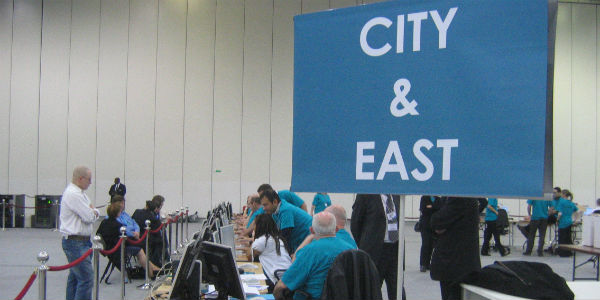No longer fit for purpose: it’s time to change the way we elect London Assembly Members
London Assembly Members are elected using the Additional Member System. It’s a big improvement on first past the post, argues Charley Jarrett, but it’s now leading to inertia, with AMs lacking an incentive to tell constituents about their work. Ten of the 14 London seats have never changed party control and there is no way to back a party without also backing their candidate, and vice versa. He makes the case for a switch to the Single Transferable Vote system.

At the London count in 2008. Photo: SecretLondon123 via a CC-BY-SA 2.0 licence
In 2000, the Greater London Authority (GLA) was established. From the technocratic Metropolitan Board of Works to the elected London County Council; from the Greater London Council (GLC) that gave the city its current boundaries, to a 14-year period of beefed up boroughs and no citywide governance – Westminster and Whitehall have always been reluctant to give Londoners too much say over their own affairs[1], and the power of pan-London government has waxed and waned.
The GLA saw the introduction of a somewhat limited (by international standards) Mayor of London, with strategic oversight over policing, transport, fire services and economic development, held accountable by an Assembly with remarkably few powers. As the Mayoralty has been given more powers, however, the need for the Assembly’s power to scrutinise has increased too.
Yet there is a worrying lack of interest or knowledge in the work of the London Assembly[2]. This may be in no small part due to a lack of competition in its elections – caused by its electoral system.
The London Assembly has always been elected by the Additional Member System (AMS). AMS is a huge improvement on First-Past-the-Post (FPTP) – and on the FPTP-style bloc-voting previously used for London Borough and former GLC elections. Nevertheless, AMS has a number of shortcomings which could be resolved through adopting the Single Transferable Vote (STV). By better encouraging Assembly Members (AMs) and candidates to compete for votes by publicising their scrutiny records, STV could help increase voters’ knowledge of the Assembly and its work. This improved accountability would be better both for voters and for London governance.
Constituency seats
One issue many electoral reformers have with FPTP is its tendency to produce safe seats. Once you become an MP for the dominant party in a safe seat, it is very unlikely you will lose your seat unless your party selectorate deselects you. So it is with the fourteen constituency AMs. Ten of these 14 seats have never changed party control. So if you are a voter in one of these ten seats (whether you tend to vote for the winning party or not) your vote means little. As with all FPTP elections, any votes in the constituency element of AMS for losing candidates or giving winning candidates a majority of more than one is wasted. In 2016, a total of 1,860,392 of these votes (77%) were wasted. Moreover, only five constituency AMs were elected with a majority of votes cast.
In some respects, then, AMS in London results in the same winner-takes-all politicians elected with minority support, safe seats and wasted votes as FPTP.
Party lists
FPTP advocates often criticise electoral reform because they do not like party lists. The Electoral Reform Society, while preferring list systems to FPTP, does not advocate party lists, as they lead to ‘partyocracy’.
Presently, party selectorates and members reward and punish Assembly list candidates by choosing the order in which they will be elected. Voters should be able to reward and punish individual incumbents, and candidates in general, without rewarding or punishing their running mates.
Under AMS, if you dislike the first-listed candidate from your favourite party, you have no way of supporting your party without also supporting that candidate. Similarly, if you like a candidate from a party you dislike, you have no way of backing the candidate without also backing that party. Even within a party, you have no means of saying at the ballot box you’d rather see – say – the fourth-listed rather than second-listed candidate elected. STV would resolve this. It encourages competition not just between parties, but between candidates and ideas: it maximises voter choice.
Because list AMs are answerable more to their parties than to voters, people are less able to identify them and the work they do. This, in turn, makes it even more difficult for them to get the praise they deserve when they’re doing well and to hold them to account when they’re not.
A further issue with AMS is the inherent asymmetry between constituency and list AMs, with reports from Scotland (where the same system is used) of tensions between the two types of member. STV would do away with the inelegance of two tiers of politicians in the same body with different roles and incentives.
Yet another peculiarity of the list element of AMS elections is that AMs who defect keep their seat, despite having been elected on a party list. This was demonstrated in 2005. Two UKIP AMs, elected just seven months earlier, defected to Veritas. Within less than a year they switched again, forming the now-defunct One London party.
If you support empowering people over parties, maximising voter choice and voice, and encouraging electoral competition and accountability, STV is the choice for you. Real awareness of the Assembly’s work could be raised if individual AMs and candidates were better incentivised to tell voters what they have been doing or would do on the Assembly. STV provides those incentives.
References
[1] Derek Keene, “Metropolitan comparisons: London as a city-state,” Historical Research 77, no. 198 (2004), p.478.
[2] Vernon Bogdanor, The New British Constitution (London: Bloomsbury Publishing, 2009).
This post represents the views of the author and not those of Democratic Audit. It was first published by the Electoral Reform Society.
 Charley Jarrett is Policy and Public Affairs Officer at the Electoral Reform Society.
Charley Jarrett is Policy and Public Affairs Officer at the Electoral Reform Society.





 Democratic Audit's core funding is provided by the Joseph Rowntree Charitable Trust. Additional funding is provided by the London School of Economics.
Democratic Audit's core funding is provided by the Joseph Rowntree Charitable Trust. Additional funding is provided by the London School of Economics.
@GeoffreyHPowell This was posted on the Democratic Audit site, former mbr of the Assembly had diff take in comments https://t.co/0dqKT7mgy4
A former AM member tells us what’s really wrong with the London Assembly – & it’s not the voting system https://t.co/fgxNVxQUXj
No longer fit for purpose: it’s time to change the way we elect London Assembly Members https://t.co/Evmq1jzhWP
No longer fit for purpose: it’s time to change the way we elect London Assembly Members https://t.co/zLpqdFVY3Q
As the former leader of the UKIP group on the London Assembly elected in 2004, I learned that the real reason why the London Assembly has little profile (and it had more then through coverage in the Evening Standard than it does today) is that it has actually no power at all, even to do its job of holding to account.
The main issue, which we raised constantly, is that members are barred from access to any any useful information – we had to apply for stuff under Freedom of Information, which made meaningful scrutiny impossible – it took months just to be told “you can’t have it because it’s commercially confidential”. So in a parody of democracy the stuff off government is transferred from public to private and then you are told you can’t have any of it because it relates to private business. And even when you want public stuff, you are given the run around in a time sensitive situation for months, leaving the real job of scrutiny to others but only in situations where they (parliament or newspapers pursuing an agenda) decide that there should be scrutiny. Hmmm.
The interesting point for me was encapsulated in a press release we sent out when the Government did its ‘review of powers of the GLA’ a couple of years in to our term. As we said “the real aim of this ‘review’ is not to increase or firm up powers, but to blunt and make useless any powers that elected members might have accidentally accrued since the GLA was set up 6 years ago. The removal of the slim but definite ability of the fire authority members to oppose the Mayor is a cert and in the end the growing power of the police authority (MPA) will also be removed”. How right we were about these two GLA agencies in which Assembly Members had a crucial role. Neutered in one case and destroyed in another – all for having accrued too much power by accident.
By all means beggar about with electoral systems – re-arranging the deckchairs on the electoral Titanic – but you will just be writing this same article again a decade or 15 years later making the same argument about the Assembly – the lesson is that real powers mean real interest. No-one is even vaguely interested in a group of people who have no meaningful powers, who are barred from access to anything of note, barred from all discussions of important matters unless they in the same party as the Mayor, and then restricted during elections from being allowed to campaign – you may wonder why you never hear a thing from Assembly candidates during the election itself…well, candidates for Mayor and Assembly are banned by law from writing personally in the mail to every one of their constituents at all (spending restrictions). And tv/radio gives the election of Assembly candidates barely any coverage at all. Only a few minutes here or there of tedious advertorial type coverage by state radio and tv for its chosen ‘main’ parties, with all others banned from tv for the entire campaign. Mayoral candidates are restricted to one government-censored ‘booklet’ which looks like a cross between a tired old fashioned pizza leaflet accidentally printed on cheap and nasty paper and a titanically tedious and unreadable 1950s rationing-era pamphlet. Assembly candidates have nothing except possibly a long and tedious list of names printed tiny at the end of the Mayor ‘leaflet’. Interesting and illuminating stuff eh? Well maybe for an election in 1936.
Thanks. for this insight
No longer fit for purpose: it’s time to change the way we elect London Assembly Members https://t.co/65I9hJUueL
No longer fit for purpose: it’s time to change the way we elect London Assembly Members https://t.co/j8rof0xGCH
No longer fit for purpose: it’s time to change the way we elect London Assembly Members https://t.co/65I9hKc56j https://t.co/vEPHOfUtIo